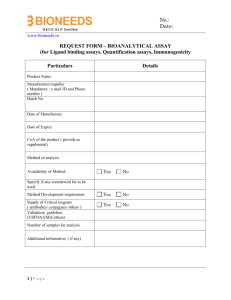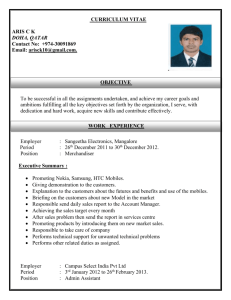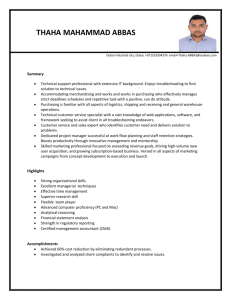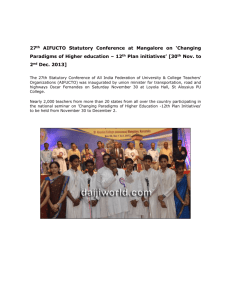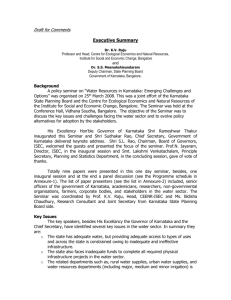Primary Sector
advertisement
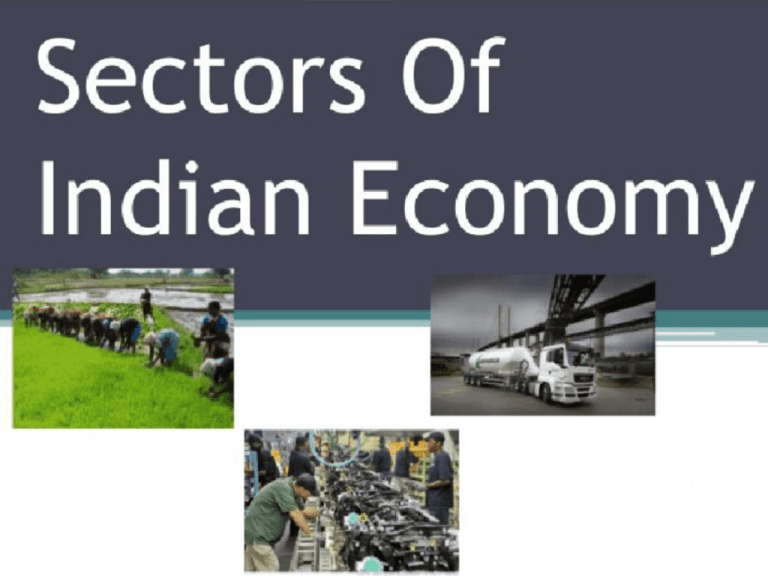
Economic Activities Production, distribution and consumption of goods and services. Agricultural, Industrial & Service Sector. Availability to the customer. To earn income, wealth for life & secure maximum satisfaction of needs. Sectors of Economy 1) Primary Sector : Depends directly on natural resources. Harvesting/Extracting of natural resources. e.g. Agriculture, Horticulture, Mineral extraction etc. 2) Secondary Sector : Manufacturing of goods using products from the Primary sector. e.g. Manufacturing of cars, clothes, sugar etc. 3) Tertiary Sector : Supporting the Primary & Secondary Sector. e.g. Banking, Insurance, Healthcare, transportation etc. PRIMARY SECTOR PRIMARY SECTOR Agriculture Importance of Agriculture : Dependency as a source of livelihood. Provides raw materials. Provides food/fodder. Foreign Exchange Resources. Source of Saving. Employment Opportunities. Agriculture Problems in Agriculture : Small farmers. Dependency on rainfall. Loss of agricultural land. Lack of knowledge of modern methods of farming. Soil Erosion. Inadequate storage facilities/wastage of food grains. SECONDARY SECTOR Manufacturing Sector Classification of Industries Based on type of raw material :1) Agro-based Industries 2) Forest-based Industries 3) Mineral-based Industries Based on type of ownership :1) Public Sector Industries 2) Private Sector Industries Agro-based Industries Sugarcane Sugar Forest-based Industries Wood Furniture Mineral-based Industries Iron Automobile Public Sector Industries Owned by the Government. Central & State owned Enterprises. Ministry of Heavy Industries and Public Enterprises. The level of financial autonomy is currently divided into three categories: 1) Maharatna : Coal India Ltd., ONGC, Steel Authority of India etc. 2) Navaratna : HP, Bharat Petroleum, HAL etc. 3) Miniratna : BSNL, BEML, Airport Authority of India etc. Private Sector Industries Owned by the Individuals & their or Group of Individuals. Motive to earn money. Area of operation – National or International. Large Scale/Medium Scale/Small Scale/Micro type Industries (MSMEs). Multinational Companies (MNCs) WIPRO Ltd, Tata Motor, Godrej, Parle Biscuits etc. Industrial Sector Importance of Industries : Higher income to the nation & foreign exchange. Employment to the people. Standard of living is lifted. Development of agriculture. Reduces the burden on agriculture & causes overall development. Better utilization of natural resources like minerals & forests products. Multinational Companies (MNCs) Multinational Companies (MNCs) An organization that owns or controls production of goods or services in one or more countries other than their home country. Importing and exporting goods and services. Making significant investments in a foreign country. Opening manufacturing facilities or assembly operations in foreign countries. One of the earliest MNCs in India : British East India Company. TERTIARY SECTOR Service Sector. Production of Services instead of end products. Known as "intangible goods“. Supporting the Primary & Secondary Sector. Examples : Banking, Insurance, Healthcare, transportation etc. TERTIARY SECTOR TERTIARY SECTOR of Agriculture More than half of workforce dependent on agriculture. 70% of activities are dependent on rainfall. Ghataprabha, Malaprabha, Narayanpura, Almatti, Tungabhadra, Hemavathi, Krishnaraj Sagar irrigation projects. Paddy, Jowar, Ragi, Bajra etc are main food crops.Cotton, sugarcane, tobacco, coffee, cardamom, pepper, coconut, banana, arecanut etc are some plantation & commercial crops. Horticulture Leading state in horticulture. Area expansion, assistance to farmers, supply of seeds, pesticides and marketing assistance. Karnataka State Horticulture Development Agency. Credit facilities by NABARD. Floriculture Leader in Floriculture industry. Leading Taluks – Devanahalli & Chikkaballapur. One of the major contributors to exports. Karnataka Agro Industries Corporation (KAIC), National Horticulture Board. Botanical Gardens. Dairy Second place in India in milk production. 4.8 million – 5 million tons of milk production. Network of veterinary centers through out Karnataka. Operation Flood. Karnataka Milk Federation (KMF). Fisheries Karnataka has 320km of coastline & 5.6 lakh hectares of inland water. No. of fishermen in the state is around 7.66 lakh. 300 lakh tons of fish production. 7 fishing harbors – Karwar, Tadri, Honnavar, Bhatkal, Gangolli, Malpe & Mangalore. Export of marine products. Industries Largest Public Sector Company in Karnataka – HAL. NAL, BHEL, ITI, BEML, BEL, HMT are located in the state.TVS plant in Mysore, TATA motors plant in Dharwad. Bangalore – Silicon Valley of India. One of the earliest state in India to establish Bio-technology Industry. Favorable government policies. Industries in Bangalore Banking Sir M. Vishweswaraiah established State Bank of Mysore in 1913. Dakshin Kannada & Udupi – Cradles of banking. Canara Bank – First to sponsor Regional Rural Banking . 27 – Public Sector commercial banks, 16 – Private commercial banks and 6 – regional Rural banks are operating in the state. State Bank of Mysore, Canara Bank, Vijaya Bank, Corporation Bank, Syndicate Bank. Tourism State with great heritage & cultural background. Tourism – One of the chief contributors to the economy State has many places of Historical importance, places of pilgrimage, Wildlife sanctuaries & National parks, Hill stations & water falls. Bangalore – Garden City of India. Karnataka State Tourism Development Corporation (KSTDC). Tourism in Karnataka Power Karnataka generates power in four different forms – Hydro, Thermal, Wind and Solar. Shivansamudra Hydroelectric power station was established in 1902. Jog falls, Shimsha river, Sharavathi, Tungabhadra, Almatti dam. Karnataka – 1st in Hydro-electric power generation. Karnataka Power Corporation Limited (KPCL). Karnataka Power Transmission Corporation Limited (KPTCL). Transport Transport sector is the lifeline of the economy. All the economic activities depend on the transport system. Karnataka state has a well developed transport network. Well organized and modern Road, Rail, Air transport. Road Transport Wide range of Road network. Pradhan Mantri Sadak Yojana. Karnataka State Road Transport Corporation (KSRTC). Among the network of roads in Karnataka, 3973 km. of roads are National Highways. Karnataka also has state highways of length 9829 km. BMTC is one of the most modern bus service provider in India. Rail Transport One of the most important modes of transport for the economy. Hubli – Headquarters of the South Western Zone. The railway network is still under development. Konkan railway network. Modern, hi-tech railway stations. Connectivity to most parts of India. Water Transport Coastline of about 320 km. 1 major port – New Mangalore Port. 10 minor ports – Karwar, Belekeri, Tadri, Honnavar, Bhatkal, Kundapur, Hangarkatta, Malpe, Padubidri and Old Mangalore. Exports from the Kudremukh Iron Ore Company limited. The sector of Inland water transport within the rivers of Karnataka is not well-developed. Air Transport International Trade of the state. Kempegowda International Airport in Bangalore ; Mangalore International Airport in Mangalore. Smaller airports at Hubli, Mysore & Belgaum. BIA is host to 9 domestic airlines and 19 international airlines. AirAsia India, Air Pegasus, Jet Airways, Air India, IndiGo and SpiceJet. Communication, Healthcare & Education Telecommunication service is provided by both Public & Private sectors. Vastly improved health infrastructure. Minimum Needs Program. Janani Suraksha Yojana, Thayi Bhagya etc. ESI Hospital, Bangalore Vast network of Private & Government Hospitals. Communication, Healthcare & Education State has a literacy of 75%. Karnataka Knowledge Commission – To meet the needs of the industry. Good network of educational institutions – Primary Schools to Professional colleges. Bangalore University Number of universities operate in the state. One of the largest source of Human Capital.
